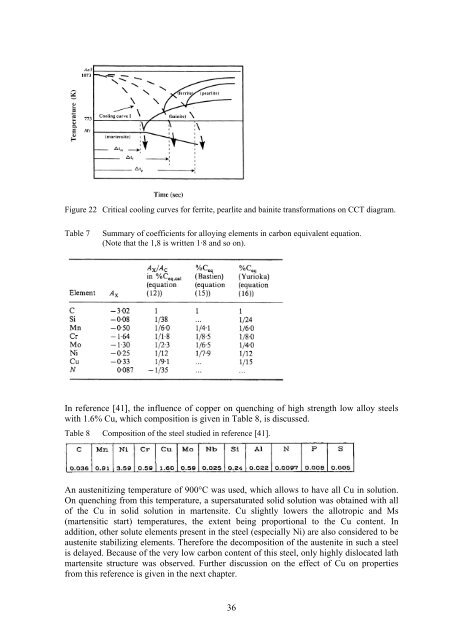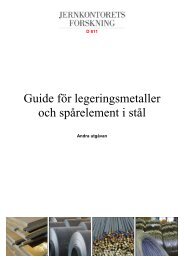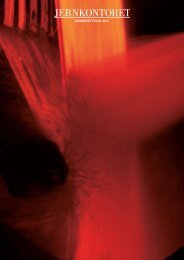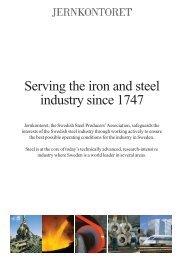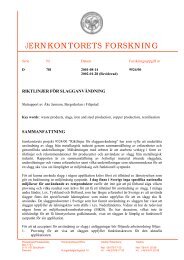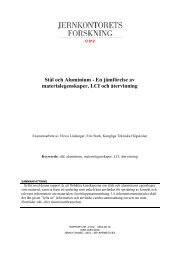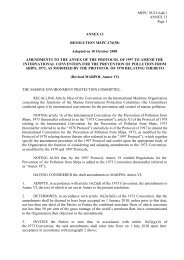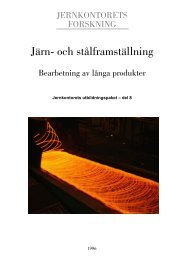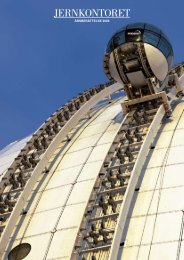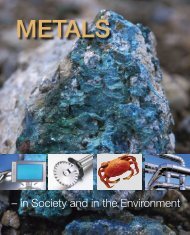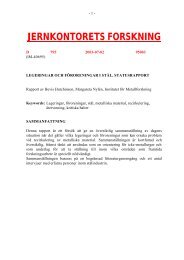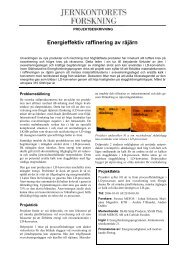5.2.2 HardenabilityReference [38] gives a summary <strong>of</strong> the most important variables, which influencehardenability, which are austenite grain size <strong>and</strong> composition, the second being discussedin this chapter.Carbon has a marked influence on hardenability, but its use at higher levels is limited,because <strong>of</strong> the lack <strong>of</strong> toughness which results, the greater difficulties in fabrication <strong>and</strong>,most important, increased probability <strong>of</strong> distortion <strong>and</strong> cracking during heat treatment <strong>and</strong>welding.Likewise, most metallic alloying <strong>elements</strong> slow down the ferrite <strong>and</strong> pearlite reactions, <strong>and</strong>so also increase hardenability. Exceptions are Co, because it increases the rate <strong>of</strong>nucleation <strong>and</strong> growth <strong>of</strong> pearlite, Ti because it reacts with C to form TiC <strong>and</strong> S because <strong>of</strong>MnS.The most economical way <strong>of</strong> increasing the hardenability <strong>of</strong> plain carbon steel is toincrease the manganese content, from 0.60 wt% to 1.40 wt%, giving a substantialimprovement in hardenability. Chromium <strong>and</strong> molybdenum are also very effective, <strong>and</strong>amongst the cheaper alloying additions per unit <strong>of</strong> increased hardenabilily. Boron has aparticularly large effect when it’s added to fully deoxidized low carbon steel, even inconcentrations <strong>of</strong> the order <strong>of</strong> 0.001%, <strong>and</strong> would be more widely used if its distribution insteel could be more easily controlled.The effect <strong>of</strong> the main <strong>residual</strong> <strong>elements</strong> (Cu, Cr, Ni, Mo, P, Si, Sn) on the hardenability <strong>of</strong>low alloyed C-steels (XC10, XC42, 20M5) is also given in reference [39]. The effect onhardenability was ranked as follows: P>Mo>Cr>Si>Ni/Cu. The effect <strong>of</strong> Ni <strong>and</strong> Cu isneglectible under 0.3%. From that, it was assessed that <strong>elements</strong> coming from scrap (Cr,Si, Mo) allow enonomy <strong>of</strong> adding <strong>elements</strong> such as Cr, <strong>of</strong>ten necessary to increasehardenability <strong>of</strong> carbon steel produced from ore.According to reference [28], copper somewhat increases the allotropic <strong>and</strong> martensitetransformation temperatures, the increase <strong>of</strong> temperature being proportional to its content.As an element weakly stabilizing austenite, copper impedes the decomposition <strong>of</strong> austenite<strong>and</strong> thereby increases the hardenablility <strong>of</strong> steel.In reference [40], the derivation <strong>of</strong> carbon equivalents to assess hardenability <strong>of</strong> steel hasbeen examined. This equivalent was derived from the incubation time before thetransformation to ferrite, pearlite or bainite, which is illustrated in Figure 22 <strong>and</strong> is given inthe equation below (note that the 1,8 is written 1·8 <strong>and</strong> so on):It was compared with experimental results from other studies, which is shown in Table 7:The comparison reveals that the calculated coefficients for silicon, manganese, copper <strong>and</strong>nickel in the carbon equivalent equation are in good agreement with the experiments,whereas the agreement for the molybdenum <strong>and</strong> chromium coefficients is poor.35
Figure 22 Critical cooling curves for ferrite, pearlite <strong>and</strong> bainite transformations on CCT diagram.Table 7Summary <strong>of</strong> coefficients for alloying <strong>elements</strong> in carbon equivalent equation.(Note that the 1,8 is written 1·8 <strong>and</strong> so on).In reference [41], the influence <strong>of</strong> copper on quenching <strong>of</strong> high strength low alloy steelswith 1.6% Cu, which composition is given in Table 8, is discussed.Table 8 Composition <strong>of</strong> the steel studied in reference [41].An austenitizing temperature <strong>of</strong> 900°C was used, which allows to have all Cu in solution.On quenching from this temperature, a supersaturated solid solution was obtained with all<strong>of</strong> the Cu in solid solution in martensite. Cu slightly lowers the allotropic <strong>and</strong> Ms(martensitic start) temperatures, the extent being proportional to the Cu content. Inaddition, other solute <strong>elements</strong> present in the steel (especially Ni) are also considered to beaustenite stabilizing <strong>elements</strong>. Therefore the decomposition <strong>of</strong> the austenite in such a steelis delayed. Because <strong>of</strong> the very low carbon content <strong>of</strong> this steel, only highly dislocated lathmartensite structure was observed. Further discussion on the effect <strong>of</strong> Cu on propertiesfrom this reference is given in the next chapter.36


